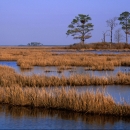About Us
Eastern Neck National Wildlife Refuge (NWR) is an island of 2,285 acres located at the confluence of the Chester River and the Chesapeake Bay in Kent County, Maryland. Native Americans hunted here for thousands of years and the island was among the first areas settled by Europeans in the "New World." Established in December 1962, the refuge is a major feeding and resting place for migratory and wintering waterfowl on Maryland’s famed “Eastern Shore.” The varied habitats on Eastern Neck NWR, including brackish tidal marsh, forest, cropland, grassland, and open water impoundments, provide a home for a variety of wildlife species. The refuge holds the designation of Important Bird Areas by the Audubon Society. Over 240 species of birds and a variety of mammals, amphibians and reptiles inhabit the island.
Our Mission
The mission of the National Wildlife Refuge System is "to administer a national network of lands and waters for the conservation, management, and where appropriate, restoration of the fish, wildlife, and plant resources and their habitats within the United States for the benefit of present and future generations of Americans.” —Refuge Improvement Act; Public Law 105-57
Eastern Neck Refuge was established by executive order on December 27, 1962, under the Migratory Bird Conservation Act (16 U.S.C. 715 d) with an official purpose “for use as an inviolate sanctuary, or for any other management purpose, for migratory birds.”
Eastern Neck NWR's Vision Statement, as stated in its latest Comprehensive Conservation Plan:
"Eastern Neck National Wildlife Refuge will sustain diverse and healthy aquatic, tidal marsh, and uplands habitats to support robust populations of Federal trust species and remain an essential link in the network of conserved lands in the Chesapeake Bay. Our successes will be supported by the strong partnerships we develop with other Federal agencies, State agencies, conservation organizations, land managers, and neighboring communities. Working with those partners will provide the opportunity to showcase and demonstrate a science-based, adaptive management approach, with emphasis on the protection and restoration of shoreline and tidal marsh.
We will continue to reward all who visit with an opportunity to immerse themselves in the natural sights and sounds of the Chesapeake Bay. The thrill of observing more than 100,000 migrating and wintering waterfowl moving in and out of the refuge each year, including the rare tundra swan, is an experience that forms a lasting impression about the wonders of nature. Visitors will also be delighted by the refuge’s healthy populations of bald eagles and ospreys as they dive for fish and attend to their young. They will also enjoy the opportunity to observe the phenomenon of over 100 species of birds migrating through each fall. We will enhance these and other refuge experiences by providing exceptional interpretive and visitor programs about the Chesapeake Bay and its rich diversity of natural and cultural resources."
Our History
During the time of the last great ice sheet ten thousand years ago, Eastern Neck Island was not an island at all. Native Americans may have paused here while hunting to look out over a wide forested valley to the west. As the last glacier melted, sea levels slowly rose. Ocean waters swallowed up the Atlantic coastal plain and drowned the river valley. About 4,000 years ago the ancient hunters would not have recognized the area where their descendants, the Woodland Period Indians, fished and gathered shellfish from the brackish waters of the Chesapeake Bay. When Captain John Smith explored this area in 1608, he made contact with the Ozinie Indians, who were related to the Algonquin-speaking Nanticokes. During the 1600’s, English settlers pressed local Native Americans onto reservations, or forced them to disperse with the Powhatans. Some Native Americans abandoned their traditional lifestyle and remained among the English.
Colonel Joseph Wickes, an early settler on Kent Island, could look east across the Chester River from his plantation on Love Point to the lands that came to be called Eastern Neck, where he decided to acquire land as well. From 1658 to 1680, Wickes and his partner, Thomas Hynson, were granted tracts until they owned all of Eastern Neck Island. They made a living by raising tobacco and other crops, and exporting them on ships built at the family’s shipyard. Hynson’s heirs eventually sold all their Eastern Neck Island lands to Wickes’ heirs, and the island was owned by the Wickes family until 1902. During the Wickes' ownership, a variety of agricultural practices took place on the island, including logging, dairying, raising sheep and horses, and growing peaches, pears, asparagus, and various other crops for subsistence and cash. A small fishing village, which included an oyster-shucking plant, was located at Bogles wharf. The Chester River Steamboat Company operated a wharf nearby that was regularly served by steamships from Baltimore and other ports.
In the early 1900s, wealthy individuals began buying portions of Eastern Neck to use as hunting retreats, attracted by the area's concentrations of waterfowl. In the 1950s, a developer bought a large tract and subdivided it into 293 small lots for a housing development. The U.S. Fish and Wildlife Service, responding to concerns over the development expressed by the local community, acquired the entire island between 1962 and 1967 to preserve its valuable wildlife habitat. Today, the Cape Chester House, the only house built in the subdivision, serves as refuge housing, while the refuge's office and visitor contact station resides in one of the hunting lodges built in 1933.
Other Facilities in this Complex
Eastern Neck National Wildlife Refuge is managed as part of the Chesapeake Marshlands NWR Complex.
